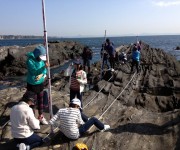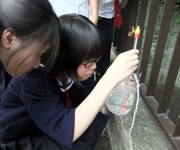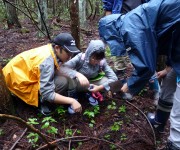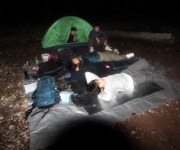- Notice
- Kanto Convention
Tokyo Conference Abstracts: Poster Presentations
2013.12.03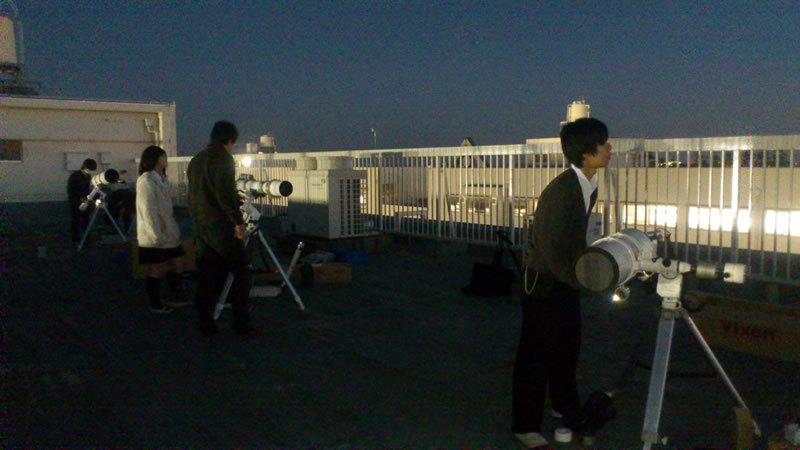
Abstracts of the presentation themes for the 2013 Tokyo Conference are now available.
- Tokyo Conference Oral Presentations
- Tokyo Conference Poster Presentation
- Osaka Conference Oral Presentation
- Osaka Conference Poster Presentation
Science Castle is looking for middle and high school students and teachers who wish to attend the presentations. Not only can you attend the presentations listed below, but you can also communicate directly with the junior high and high school students and teachers involved in the research. Please apply for participation below.
https://s-castle.com/castle2013/join
Tokyo Conference Poster Presentation Theme Abstract List
Themes for poster presentations only are listed. Schools making oral presentations will also make poster presentations.Abstracts of Oral PresentationsPlease check the "Exhibitors' Guide" for more information. Please note that there is no Q&A time for oral presentations, so please use the time for poster presentations as Q&A time.
[accordions]
[accordion title="Community-based! Stargazing & Planetarium for Elementary School Students (Yokohama Municipal Sakuragaoka High School Astronomy Club)"]
Purpose of Activity
Bringing the fascination of the world of stars to local elementary school students
Summary of Activities
We give back the results of our usual activities to local elementary school students. In addition to stargazing, we create and project new scenarios each time at Planet. We also create items such as a handmade star chart. We have made many new discoveries in "Omo-tenashi" (hospitality). [/accordion] [accordion title="Phototaxis of Planaria (Ichikawa Gakuen Ichikawa High School, Biology Club)"]
Purpose of Activity
We were interested in the light avoidance response of planaria, and conducted experiments to determine if there were differences in the magnitude of the response depending on the color.
Summary of Activities
We experimented with the response of planaria to different colors of light. At first, we used five colors (blue, green, yellow, red, and white) and found that the response to red light was sluggish. We then repeated the experiment on the response to red color, but the sluggishness of the response did not change after repeated experiments, so we looked at the response when light with shorter wavelengths than red was shone on them. [/accordion] [accordion title="Glycans and Colony Formation in Escherichia coli (Ichikawa Gakuen Ichikawa High School, Biology Department)"]
Purpose of Activity
I became interested in sugar chains when I read that sugar chains are involved in viral infections, and I tried to find out how sugar chains affect cell activities.
Summary of Activities
We hypothesized, "If we affect the sugar chains of E. coli, we may see changes in their colonies." First, we set out to find sugar-degrading enzymes that affect the colony formation of E. coli. The method was to culture E. coli and sugar-degrading enzymes together and look at their colonies. The enzymes we prepared were cellulase, macerozyme, and pectolyase. Of these, those cultured with cellulase had fewer colonies. This indicates that cellulase may affect the sugar chain of E. coli. In the future, we intend to examine how the cellulase has changed through microscopic observation, and to investigate whether the cellulase has really affected the sugar chains and suppressed colony formation.
[/accordion]
[accordion title="Astronomy Club Activity Report 2013 (Tokyo Metropolitan Hibiya High School Astronomy Club)"]
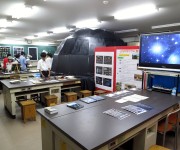
Purpose of Activity
The Astronomy Club engages in a variety of activities under the motto "enjoy observing the stars.
Summary of Activities
This year, many first-year students joined the Astronomy Club, bringing the total number of members to over 30.
The main pillars of our activities are the annual training camp and the planetarium at the cultural festival, which attracts a large number of visitors and promotes astronomy.
Usually, we offer learning sessions on constellations, planetarium tours, astrophotography, and observation of the sun and moon.
We will be presenting a new attempt at the planetarium, which was renewed this year, and an attempt at daytime observation of Comet ISON. [/accordion] [accordion title="On the Propulsive Force Changing with the Shape of Fins (Physics and Chemistry Club, Nirasaki High School, Yamanashi)"]
Purpose of Activity
Physics is the study of "our own world" and explores what constitutes the world from familiar events.
Summary of Activities
The current activity is directed toward the "Fin Propulsion Contest" being held at Yokohama National University. This contest is a speed competition for boats with propulsion devices that mimic the propulsion organs of fish.
Since hydrodynamics is involved in the propulsion of a ship, this leads to the study of physics. First, we are studying the shape of the fins. [/accordion] [accordion title="Soil Environment Research on Mt. Amari (Environmental Science Department, Yamanashi Prefectural Nirasaki High School)"]
Purpose of Activity
We investigate and analyze environmental issues that are being discussed these days from the perspective of high school students, using familiar subjects as the starting point, and work to protect and improve the environment.
Summary of Activities
Mt. Amari (1731 m above sea level) is located in the eastern part of Nirasaki City, Yamanashi Prefecture, and has been known as a famous place for Renge-tsutsuji azalea. According to the NPO Amariyama Club, the main cause is feeding damage by deer. We started a survey in July 2013. We are investigating seasonal variations in soil water holding capacity, pH, phosphate concentration, and the presence of microorganisms. In addition, we will conduct similar surveys in urban areas and other mountains (Kiyosato Bishinomori Forest and Mt. [/accordion]
[accordion title="SPP "Exploring rock-forming minerals: optical properties of pyroxene, hornblende, and quartz" (Tokyo Metropolitan Shiroogaki High School SPP-A Group (4th grade)) )"]

Purpose of Activity
We will prepare thin sections of single crystals of major rock-forming minerals in igneous rocks and observe their optical properties with a polarizing microscope to investigate the relationship with physical properties based on the crystal structure, such as cleavage.
Summary of Activities
Under the guidance of Professor Satoshi Harayama of the Department of Geological Sciences, Faculty of Science, Shinshu University, the students collected major rock minerals such as pyroxene, hornblende, and quartz in Nagano Prefecture, prepared thin specimens based on crystal axes in the university laboratory, and observed and measured their optical properties using polarized light microscopes. The program was experienced. [/accordion] [accordion title="SPP "Tracing the Traces of the Miura Peninsula Earthquake" (SPP-C Group (Jr. 2), Junior High School attached to Shiraogi High School, Tokyo)"]
Purpose of Activity
Observe and measure the sea cliffs and sea terraces that form the coastal terraces at Jōgashima, Miura Peninsula, to experience the earthquakes and learn about the causes of earthquakes.
Summary of Activities
Field training at Jōgashima Island on the Miura Peninsula, where clear strata are widely distributed.
The main features of the site are the distinctive sedimentary structures, such as the stratified stratigraphy and frame structures, as well as the
They observed faults and experienced the geological structure firsthand. In addition, they experienced firsthand the geological structure of the sea.
Sea stacks and sea cliffs that form shore terraces to hand level and staff.
The survey was conducted by
Based on field surveying and aerial photo interpretation, especially for coastal terraces,
Terraces caused by earthquakes and terraces caused by climate change, which are different.
The first time, the company explored the issue of the "new" market.
1st lecture: Lecture on the topography and geology of Jogashima
2nd: Field trip to Jogashima (measurement of terrace elevation, stratigraphic observation, observation of drilled shell fossil remains)
Third session: Practical training on how to read maps and aerial photographs, review and summary of the inspection tour
4th: In-school presentation
Purpose of Activity
This program is a project supported by the Japan Science and Technology Agency (JST) and aims to promote science club activities in junior high schools and high schools.
Summary of Activities
Our school is located in the heart of the city near Tokyo Tower, which is the most unfavorable location in Japan for astronomical observation due to the intense light pollution. Under such circumstances, our school has been selected and supported by JST for three years since 2011 as a "Science Club Activity Promotion Project" under the title of "Astronomy in the Heart of the City".
In 2013, we have conducted planetarium commentary by university students, open astronomical observation sessions, summer camp at Dodaira Observatory, and presentations at cultural festivals. In this presentation, we would like to present a poster exhibition of the activities we have conducted over the past three years. [/accordion] [accordion title="Water Quality Survey of Shakujii River and Biotope Pond (Science Club, Tokyo Kasei University Girls Junior High School)"]
Purpose of Activity
Investigate the connection between the natural environment and living creatures in urban areas through biotope maintenance activities, surveys of living creatures at the school, and water quality and biological surveys of ponds.
Summary of Activities
Since April 2010, our school's science club has been conducting monthly chemical investigations of the water in the Shakujii River (Kaga Bridge: downstream area), which flows near the school, and the biotope pond, using air temperature, water temperature, pH, and various pack tests, and investigating small organisms in the water. This research was adopted by the "Science Club Activity Promotion Project for Junior and Senior High School Students," a consistent part of the SPP in JST since 2012.
Continuous research has revealed that there are differences in seasonal changes in water quality and organisms found in the water due to differences in environmental conditions such as "running water as an urban river" and "water in an artificial pond. Currently, a permanent prepartement is being made and research is underway to identify the diatom species. [/accordion]
What are the differences between a day-flowing river and a non-flowing biotope? We are studying this from two approaches: a biological and a chemical point of view. Cute (?) You will be able to see some pictures.
[accordion title="Strawberry Breeding (Eito Junior & Senior High School Gardening Club)"]Purpose of Activity
Students learn how strawberries, a familiar fruit, are created as a variety at the Saitama Prefectural Institute of Horticulture, and deepen their understanding of the purpose and methods of breeding.
Summary of Activities
With regard to strawberry breeding, we have held six lectures and practical training sessions this year at the Saitama Prefectural Institute of Horticulture on breeding methods and timing of crossbreeding. Throughout the year, students learn specifically how plants change and what it takes to create a variety. [/accordion] [accordion title="What is Radiation? Food and Plants Edition (Kanagawa University Junior & Senior High School, Science Department)"]
Purpose of Activity
To understand radiation by studying various aspects of what radiation is.
To find a way to communicate in a way that is easy to understand in their own words.
Summary of Activities
Since 2010, we have been conducting exploratory activities related to radiation with the cooperation of various research institutions. This year, we measured the radioactivity of potassium 40 contained in food, and confirmed that naturally radioactive materials are present in the food we eat everyday. In addition, to investigate the effects of radiation on plants, we irradiated kaiware broccoli and mizuna seeds with γ-rays and observed their germination rate and growth. In addition, we irradiated glass and calculators with different doses of γ-rays to examine the degree of coloration and the effects on electrical equipment. [/accordion]
[accordion title="Ecology and habitat of fireflies and salamanders in satoyama (Kimitsu Junior High School, Kimitsu City, Chiba Prefecture, Japan) Kimichu Ikimonokakari"]
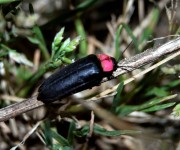
Purpose of Activity
Environmental surveys (firefly and salamander habitat surveys and water quality surveys) are underway in the satoyama areas around Koka, Kimitsu City and Izujima, Kisarazu City.
Summary of Activities
We are investigating the population and water quality of Genji and Hayake fireflies in Koka (Mishunosato), Kimitsu City, and the habitat of the Tokiou salamander in Izujima, Kisarazu City. We are also examining methods of rearing Genji firefly larvae and the Tokyou salamander in order to learn about the ecology of fireflies and salamanders.
This research is supported by the Program for Promotion of Science Club Activities by Junior and Senior High School Students of the Japan Science and Technology Agency, in collaboration with the Chiba Prefectural Central Museum, the Department of Environmental and Urban Engineering of the Kisarazu National College of Technology, and the Kazusa DNA Research Institute. [/accordion] [accordion title="Research on falling asleep in class - What measures are needed to prevent falling asleep (Ibaraki Christ Church Gakuen High School, Biology Department Sleep Research Group)"]
Purpose of Activity
Is it safe to say that the cause of falling asleep in class is a lack of sleep or a feeling of being asleep? We began this study to determine the causes of nodding off during class and to establish countermeasures against nodding off.
Summary of Activities
Questionnaires and observations were conducted to determine the causes of drowsiness in the classroom. The results showed that school sleepiness peaked in the morning and at noon, and that the causes were related to high carbon dioxide levels, satiety, and the nature of the teacher's voice. From the possible napping countermeasures based on these results, those that could be practiced personally and easily were selected, along with those that are commonly practiced, and their effectiveness was tested. It was found that napping was the most effective. However, since there were misunderstandings due to insufficient explanations to the subjects during the verification, accurate results were not obtained. We would like to continue to verify which measures are most effective. [/accordion] [accordion title="Analysis of cocoon structure of silkworm water-renewal varieties (Biology Department, Gunma Prefectural Takasaki Girls' High School)"]
Purpose of Activity
To determine the structure of silkworm cocoons, whose threads unravel simply by soaking in water, by analyzing electron micrographs and the solubility of sericin, the adhesive agent. To conduct genetic analysis of genes related to the structure.
Summary of Activities
We analyzed electron micrographs of cocoon cross-sections of silkworm varieties that unravel in water (mizuneri varieties) bred at the Tokyo University of Agriculture and Technology to determine the percentage of gaps, and compared them with those of practical varieties to examine the characteristics of the structure of mizuneri varieties. The percentage of sericin, an adhesion protein that dissolves in water, was also examined at 100°C, 60°C, 50°C, and 40°C, and compared with that of practical varieties.
For the analysis of genes related to structure, BF1 was created by backcrossing the F1 of the paddy variety with a non-paddy variety (recessive). The segregation of cocoon structure in BF1 was examined by measuring the length and width of cocoons. In this case, since it is difficult to understand if the data values are used as they are, a separation model was created by approximating a normal distribution. [/accordion] [accordion title="Effects of washing and disinfection on bacteria on hands (Science Department, Sugito High School, Saitama Prefecture)"]
Purpose of Activity
The purpose of the experiment was to determine the extent to which hand washing and disinfection reduces the amount of bacteria on the hands.
Summary of Activities
Bacteria were collected from between the fingers and from the palms of the hands, cultured on agar medium, and the number of bacteria was measured by counting colonies. Bacteria were collected from unwashed, water-washed, soap-washed, and alcohol-sanitized hands. The results showed that, contrary to expectations, the number of bacteria on the unwashed hands was lower than the others. We hypothesized that one of the reasons for this was the presence of substances in the hands that inhibit the growth of bacteria. Therefore, when bacterial suspensions from unwashed hands were added to bacterial suspensions collected from hands that had been washed with water, soap, and alcohol, and then cultured, the bacterial counts were lower than those that had not been added. This led us to believe that there was a substance present in the hands that inhibited bacterial growth. [/accordion] [accordion title="Elucidation of the Scientific Basis of Atopy Treatment with Seawater (Yamagata Prefectural Tsuruoka Minami High School, Keio University, Institute for Advanced Biosciences, Special Research Student)"]
Purpose of Activity
I have an experience that my atopy was improved by sea bathing when I was a child. This time, I conducted an investigation to see if seawater really affects atopic dermatitis.
Summary of Activities
There is a folk remedy that says dipping atopic dermatitis in seawater cures it. However, so far there is no scientific evidence to support this claim. In this study, we examined the effects of seawater on the skin of atopic subjects by immersing their left arm in seawater for 30 minutes for 10 consecutive days and comparing it to the untreated right arm. DNA was extracted from the samples, amplified by PCR, and sequenced for phylogenetic analysis. The results showed that a type of acne bacillus increased in the seawater-applied left arm with each passing day. qPCR showed that the number of bacteria increased not only proportionally but also quantitatively. The advantage of the increase in acne bacteria is that it keeps the skin mildly acidic and inhibits the entry and growth of other pathogenic bacteria. We would like to continue our research in the future. [/accordion] [accordion title="Search for plastic-degrading bacteria in Kawagoe soil! (Yamamura Gakuen High School, Special Preparatory Course SA Course 1st Year, Special Preparatory Course Separate Course Year, General Preparatory Course Selected Class 3rd Year)"]
Purpose of Activity
One of the goals of the school's Science Festival was to let students experience the joy of experimentation and observation.
Summary of Activities
During the summer vacation, the students received a lecture on bacteria, and in early October, soil samples were taken from the area near the school to check for the presence of decomposing bacteria. Based on the results, he further investigated in what places and under what conditions the decomposing bacteria were present. [/accordion] [accordion title="Comparison of woody biomass and seaweed biomass (3rd grade, Ono Gakuen Girls' Junior High School)"]
Purpose of Activity
In collaboration with Tokyo University of Agriculture and Technology and Kochi University, the Science Partnership Program was held under the theme of "Learning the cutting edge of biomass research for building a recycling-oriented society of the future.
Summary of Activities
Biomass is attracting attention as a renewable energy source because of its carbon neutrality and other characteristics, but there have been no reports comparing two types of biomass, woody biomass and seaweed biomass. Therefore, we prepared manual sections of larch (a conifer) and beech (a broad-leaved tree) as woody biomass (trees), and green alga and southern blue-green algae as seaweed biomass (sea weed), and observed the cells using an optical microscope. The similarities and differences between the trees and seaweeds in terms of growth location, composition, and organization from the standpoint of organisms, and in terms of growth rate, biomass, and utilization from the standpoint of biomass, were examined. [/accordion]
[accordion title="Vegetation and Conservation of the Shonan Coast: Hamabofu and Hamanigana (Shonan Gakuen Junior High School Science Research Club)"]
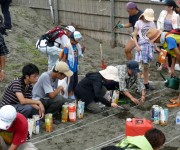
Purpose of Activity
Observations and biological surveys were conducted through camps and field activities with the aim of contributing to biodiversity conservation. Here, we will present the results of our research on the conservation of the Hamaboufushi (Lonchura fuscata), vegetation surveys, and the location of Hamanigana growth on the Shonan coast.
Summary of Activities
In cooperation with NPO Yui, which is working on restoration of the beach plant Hamaboufu, which has become rare on the Shonan coast, we raised and transplanted Hamaboufu seedlings (200 seedlings in FY2010), but many did not become established due to sedimentation. On the other hand, the results of the coastal vegetation survey showed that 17 species (12 coastal species) appeared from Kugenuma Beach to Tsujido Beach in Fujisawa City. The number of species decreased from the east to the west, but this was thought to be an anthropogenic effect. The hypothesis that Hamanigana grows in depressions was not proven, but it was found to grow at elevations between 300 and 370 cm, with a maximum cover of 2 at 350 cm elevation. It was also thought that a study of the location of Hamanigana growth using this method would be useful in selecting transplant sites for restoration. [/accordion]
"Hey, could it be that these flowers are more common in dune depressions?" Research started from a simple question. Based on this research, we may be able to increase the number of rare plants!
[accordion title="Can hardwood forests be restored in cedar logging areas in the Akaya Forest? (Shonan Gakuen Junior and Senior High School Science Research Club)"]Purpose of Activity
Observational meetings and biological surveys were conducted through camps and field activities with the aim of contributing to biodiversity conservation. Here, we present some of the results of a survey of beech-konara oak seedlings at the Kojimata test site in Minakami-machi, Gunma Prefecture, and their tracking after the cedar forest was cleared.
Summary of Activities
Akaya Forest is a progressive area where the Forestry Agency, the Nature Conservation Society of Japan, and the local community council are working together to enrich biodiversity as the Akaya Project. During the camp, participants observed the rich nature of the Akaya forest and learned that local people's livelihoods benefit from the local biodiversity. 2010, a survey of beech and konara oak seedlings before cedar logging was conducted in a 40m x 140m plot in the Koemata test site, where research is being conducted to restore cedar plantations to broad-leaved forest. It was found that beech seedlings were abundant in natural forests and scarce in cedar forests, and that seedlings of second year or older were scattered throughout the forest. Quercus serrata seedlings were abundant in cedar forests at the edge of natural forests, but only the current year's seedlings were observed. Seed dispersal and distribution of seedlings after logging of cedar forests are currently being analyzed. [/accordion]
Artificial forests can be converted back to hardwood forests! How are seeds transported from neighboring forests to build forests on former logging sites? We have taken the first step in our research.
[accordion title="Ecological Survey at Izunuma Aquatic Botanical Garden (Shonan Gakuen Junior & Senior High School Science Research Club)"]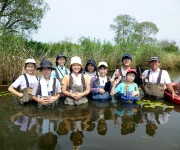
Purpose of Activity
With the aim of contributing to biodiversity conservation, a biological survey was conducted at the camp. Here, we present the relationship between aquatic biodiversity and the environment and the problem of invasive alien species in Izunuma, Kurihara City, Miyagi Prefecture.
Summary of Activities
Izunuma is a Ramsar wetland, and large waterfowl such as geese were observed during the winter camp. In the summer camp, with the guidance and cooperation of the Miyagi Prefecture Izunuma-Uchinuma Environmental Conservation Foundation, we measured transparency, dissolved oxygen concentration (DO), pH, chlorophyll concentration (CL), and electrical conductivity, and conducted biological surveys in the seven aquatic plant garden research ponds established in Izunuma. Here, 43 animal and 17 plant species were observed, with the number of species occurring in each research pond varying from 14 to 27. The relationships among transparency, DO, and CL were also discussed. In the study ponds without American crayfish, there were more bullfrog larvae and more floating and submerged plants. In addition, a fixed net survey of Izunuma Swamp was conducted, and 11 species of fish were identified, including largemouth bass and bluegill, both of which are specified alien species. [/accordion]
Izunuma is the second Ramsar site in Japan. One of the largest wintering grounds for migratory birds in Japan, we investigated its ecosystem with our own hands. This presentation will make you think about alien species.
[accordion title="Changes in Gene Technology (St. Joseph's High School, 1st Year Regular Course)"]Purpose of Activity
Find out about genes, cloning technology, and iPS cells
Summary of Activities
The cloning technology at the time of Dolly's birth in February 1997 and the current state-of-the-art genetic technology will be examined to determine how it has changed and to what extent it is now easier to experiment with it.
Examine how iPS cells are produced with current genetic technology, how it differs from cloning technology, and what the problems are. [/accordion] [accordion title="Development of Motion Analysis Technology by Arduino+XBee (Model Craft Club, Chiba Prefectural Keiyo Technical High School)"]
Purpose of Activity
The model rocket is equipped with an acceleration sensor to measure the rocket's acceleration, velocity, and altitude, thereby displaying the model rocket's movement in real time.
Summary of Activities
We aim to acquire real-time data on acceleration, velocity, and altitude at the time of launch by installing acceleration sensors and other sensors on the model rocket and transmitting the information wirelessly. The sensor information is measured by Arduino Micro and transmitted wirelessly to a PC by Xbee. As a preliminary experiment, we placed the device on a mechanical dolly and let it glide horizontally with the engine of a model rocket to verify the hardware and software operation. The results are reported. [/accordion] [accordion title="Environmental Factors Influencing Taste - Relationship with Temperature" (Taste Group, Tsuru High School, Yamanashi)"]
Purpose of Activity
To determine how the human sense of taste responds to physiological and environmental changes and whether there are differences among the five types of tastes, such as sweetness.
Summary of Activities
We perceive the external world using the so-called five senses, including sight and hearing. Although little attention has been paid to the human sense of taste, it is an important sense for many animals, as it is closely related to food. Our research has focused on changes in this sense of taste. In sweet and sour tastes, we investigated the effects of temperature change and aroma change on taste perception. As a result, we found that both sweet and sour tastes increase with increasing temperature and adding aroma. Similar experiments on temperature changes for bitter and salty tastes showed that salty taste increased with increasing temperature, while bitter taste decreased with increasing temperature. The relationship between taste and physiological and environmental factors was discussed. [/accordion] [accordion title="Environmental Impact Assessment of Artificial Chemicals Using Plants" (Environmental Toxicity Group, Tsuru High School, Yamanashi)"]
Purpose of Activity
To measure the impact of man-made products we use in our daily lives, such as detergents and anti-freeze, on living organisms and to assess their impact on the environment.
Summary of Activities
We use many man-made synthetic chemicals in our daily lives. For example, pesticides, various detergents, and anti-freezing agents sprayed on roads and grounds during the winter season. I decided to conduct this research because I am interested in the effects of these man-made substances, which are supplied to the environment in large quantities, on living organisms. The materials used in my research were sea squirt, moss, and Japanese medlar. The color fading of the Japanese pampas grass given a synthetic detergent tended to slow down. Mosses and Japanese mosses fed calcium chloride tended to die as the concentration of calcium chloride increased. These results discussed the effects of man-made substances supplied to ecosystems from our daily lives. [/accordion] [accordion title="Learn the forefront of earthquake research and consider and practice what we can do. (Disaster Prevention, Prediction) (Physics Department, Tokai University Urayasu High School)"]
Purpose of Activity
Based on the experience of liquefaction and other problems caused by the Great East Japan Earthquake, we will consider whether it is possible to predict and take countermeasures against future earthquakes and research ways to do so.
Summary of Activities
This was the first year the program was adopted for the promotion of science clubs for middle and high school students.
- Tokai University Research Center for Earthquake Prediction
- Tokyo Gakugei University
- Shizuoka Prefecture Earthquake Disaster Prevention Center
The students acquired basic knowledge about earthquakes in cooperation with Developing from there, they learned about the current state of earthquake prediction and how to apply it to earthquake prediction and shooting star observation using FM radio wave observation data. This time, I will present the contents of this study. Although it is still in the preparatory stage in the first year of adoption, we plan to install an FM antenna on the rooftop and start acquiring data. I will also briefly touch on the method and how to analyze the data. [/accordion] [accordion title="The Structure of the Earth's Atmosphere Based on Observations of Shooting Stars. (Physics Club, Tokai University Urayasu High School)"]
Purpose of Activity
Based on data analysis of the Perseids and Geminids meteor showers, we will consider the characteristics of shooting stars and the Earth's atmospheric structure.
Summary of Activities
This was the first year the program was adopted for the promotion of science clubs for junior and senior high school students. In collaboration with the "Kawasaki Museum of Space and Green Science," students learned about the structure of shooting stars, observation methods, and photography. The actual observation experience using the planetarium was more effective in acquiring observation techniques for astronomical observations that cannot be redone. Based on the knowledge and techniques acquired here, we observed the Perseids and Geminids meteor showers. Based on this observation data, we considered the changes in the number of meteor appearances, the analysis of their paths from photographs, the structure of the Earth's atmosphere, and the differences in their composition at different altitudes. The acquisition of basic knowledge and preparation for FM radio observations will also be touched upon. [/accordion] [accordion title="Japanese Honeybee Behavior and Local Nature (Biology Club, Sumidagawa High School, Tokyo)"]
Purpose of Activity
The main purpose of our school's Japanese honey bee keeping is to learn about the nature of the region through bee keeping, and also to let the local community know that the area is safe and less affected by pesticides and other chemicals.
Summary of Activities
We are conducting a pollen survey of bees to learn more about the natural environment near our school. We directly collect pollen brought back by bees and examine the types of pollen. Since pollen collected from bees alone is not sufficient to determine the types of pollen, we also conducted a tree survey in parallel. The club members actually walked and searched for trees that bees might use within a radius of 2 km, which is said to be the bees' radius of activity.
We also present the results of our surveys to the local community to make them aware of the natural environment. Outside of the school, we participate in the national conference of the Japan Society for Biological Education, presentations by the Japan Science and Technology Agency, which supports our activities, local environmental fairs, and present the results of our research at school poster presentations, cultural festivals, and other events. [/accordion]
[accordion title="On the black chromatophores of goldfish (Tokyo University of Agriculture First High School, Biology Department, Fish Group)"]
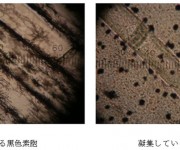
Purpose of Activity
I want everyone to understand the ecology of goldfish as well as its depth and interest.
Summary of Activities
When a lingcod is sick, black chromatophores may appear on the tips of the fins of some individuals when reared in a saline solution of around 0.6%. We investigated the relationship between saline solution and black chromatophores in Pseudopleuronectes and studied the nature of the black chromatophores that appeared. In the process, we also noticed a possible relationship between water temperature and the appearance of black chromatophores, and investigated the relationship between temperature and black chromatophores and the properties of the black chromatophores that appeared. By elucidating the relationship between salinity and water temperature on the appearance of black chromatophores, we believe that we may be able to control the color pattern that determines the ornamental value of lingcod as an ornamental fish, which may lead to the production of a higher quality lingcod than the conventional lingcod. [/accordion]
Known findings in killifish are the same in goldfish! What about the ancestor of goldfish, the crucian carp? This is a presentation of a study that has been devised over the past year! Interesting results.
[accordion title="Movement of ink when dripping into water (SSII Chemistry course, Toyama High School, Tokyo)"]Purpose of Activity
Finding regularity in the movement of sumi ink in water. In this experiment, to observe how the ink spreads, we changed the viscosity of the aqueous solution in which the ink drops were dropped.
Summary of Activities
Experiments were conducted with different viscosities: ethanol solution, tap water, and glycerin solution. The first drop of ink was faster in the less viscous solution, but the second drop was faster in the more viscous solution. This suggests that a highly viscous aqueous solution may push the ink back to the top, which causes more ink to accumulate on the water surface and slows the speed of the second descent. [/accordion] [accordion title="Study on Somatic Cell Division in Plants - Why 10:30 (Fukushima Prefectural Aizu Gakuho Junior & Senior High School SSH Exploration Club, 1st & 2nd Year Somatic Cell Group)"]
Purpose of Activity
Experimental literature states that somatic cell division at the root tips of plants is most active at 10:30. We tested the cause of this by setting up test plots with different conditions for each of temperature and sunlight, and fixing the root tips every 2 hours.
Summary of Activities
Garlic was used as experimental material and grown hydroponically in a thermostatic apparatus. The test zones for temperature and sunlight were set based on optimal growing conditions. The details are as follows (Temperature: (1) 13°C, (2) 18°C, (3) 23°C) (Daylight: (1) Normal (lighting from 6:00 to 18:00), (2) Day-night (lighting from 18:00 to 6:00), (3) Constant darkness (lights off for 24 hours)) Root-end cutting and fixing time was set every 2 hours based on 10:30, and 10 roots were collected each time. Samples prepared by the crushing method were examined and the total number of cells in the screen and the percentage of cells in mitosis at each time were determined by counting the total number of cells in the screen and the number of cells in mitosis. Two conclusions are as follows.
- Two peaks of the divisional period are seen at 8:30 and 20:30.
- The peak at 10:30 is not observed. (2) Somatic cell division at the root end is strongly influenced by sunlight conditions.
Purpose of Activity
Conduct a distribution survey of dandelions living in Sagami Women's University, aiming to conserve native dandelions, which are declining due to the introduction of non-native species and changes in the natural environment.
Summary of Activities
Distribution survey of dandelion by DNA analysis.
- Collect dandelion leaves from the campus during the dandelion blooming season (March to May) and freeze them.
- Extract DNA from collected dandelion leaves.
- Perform DNA identification experiments to determine dandelion species using PCR, restriction enzyme, and electrophoresis methods.
- The collection location data will be matched with DNA analysis results to create a map showing the distribution of dandelions living in the school.
[Future plans
- Aiming to preserve and grow cantaloupe collected in the school by cell culture using plant hormones.
- Cultivate and artificially grow dandelions in certain areas of the school to conserve the Cantonese dandelion.
Purpose of Activity
Examine the differences between sun and shade plants and, based on these results, why sun plants grow in the sun and shade plants grow in the shade.
Summary of Activities
Plants in the school were collected and sun and shade plants were selected. The sun plants were daphne and dandelion, and the shade plants were dokudami. Since enokogogusa grew on both sides, we used sun enokogusa and shade enokogusa for ease of comparison. We then discussed the definitions of sun and shade and examined ways to test our hypotheses. We made vegetation maps, measured temperature and humidity during growth, photographed growth sites and rhizome leaves, photoperiodicity, DNA extraction from plants, PCR method, electrophoresis, purification of genes, determination of protein gene sequences by DNA sequencing (requested by Tokai University Analysis Center), and analysis of contained proteins by SDS-PAGE, Analysis of vegetation differences was performed. [/accordion] [accordion title="Determination of antimicrobial effect of natural antiseptics by paper disk method (Yamamura Gakuen Yamamura International High School, Biology Department)"]
Purpose of Activity
The antimicrobial efficacy of processed antimicrobial foodstuffs and bento sheets with natural preservatives to prevent microbial food poisoning was measured, paper discs were used for measurement, and comparison was attempted from the growth inhibition circle that inhibits Bacillus subtilis natto.
Summary of Activities
The processed ingredient wasabi (1.00) had the highest antimicrobial effect and contained strong volatile antimicrobial components. Honkashi (0.53) showed half the antimicrobial effect, but this was due to a decrease in volatile antimicrobial components. Ume plum (0.31) showed an acid antimicrobial effect. Raw ginger (0.17) and raw garlic (0.13) also showed a decrease in antimicrobial effect, but these do not have strong volatile antimicrobial components. These results confirmed the high antimicrobial effect of processed antimicrobial ingredients with volatile antimicrobial components. On the other hand, the surface of the bento sheet (0.47) showed an antimicrobial effect due to volatile components similar to that of the main mustard, surpassing that of the plum paste. However, the back side (0.00) showed no antimicrobial effect at all. These results confirm the importance of bento sheets in the use of bento sheets. [/accordion] [accordion title="Determination of Antimicrobial Effects of Spices and Seasonings by Paper Disc Method (Yamamura Gakuen Yamamura International High School, Biology Department)"]
Purpose of Activity
We measured the antimicrobial effects of spices and seasonings and attempted to rank them in contrast to these antimicrobial ingredients. Paper discs were used for the measurement, and the comparison was made based on the growth inhibition circle that inhibits Bacillus subtilis natto.
Summary of Activities
The spices and seasonings with the greatest antimicrobial effect (1.00) were horseradish and mustard, which contain volatile hot pepper oil as an antimicrobial component. The antimicrobial efficacy decreased in vinegar (0.50) and ume plum paste (0.32), whose antimicrobial components are acids. The antimicrobial effect was further reduced in ginger (0.18) and garlic (0.12), where the antimicrobial components were zingerone (aroma) and allicin (odor). Soy sauce (0.12) also has a low antimicrobial effect and its antimicrobial component is salt. On the other hand, pepper (0.00) and cooking wine (0.00) have no antimicrobial effect, and their antimicrobial components are capsaicin (pungent) and ethanol (bactericidal). Based on these results, spices and seasonings contain antimicrobial components, and the antimicrobial effect of these different components allows us to rank them in an ordinal order. [/accordion] [accordion title="Comparison of the amount of spice oil component and antimicrobial effect of antimicrobial food ingredients using the Soxhlet method (Yamamura Gakuen Yamamura International High School, Biology Department)"]
Purpose of Activity
The antimicrobial component in antimicrobial foodstuffs is present in the form of hot pepper oil. Therefore, using a Soxhlet fat extractor, we attempted to compare the amount (mg) of hot pepper oil components in antimicrobial foodstuffs and their antimicrobial effects.
Summary of Activities
Processed horseradish (250 mg), which has the highest amount of hot pepper oil component, showed a high antimicrobial effect. Processed mustard (140 mg), which had the next highest amount of hot pepper oil, showed half the antimicrobial effect due to a decrease in the amount of hot pepper oil component. Processed ginger (35 mg), natural ginger (30 mg), and processed garlic (20 mg) also showed a small amount of hot pepper oil component and reduced antimicrobial effect. These results confirm the relationship between the amount of hot pepper oil component and antimicrobial effect. On the other hand, natural wasabi (30 mg) has a small amount of hot pepper oil component, but its antimicrobial effect is the same as that of processed mustard. Natural garlic (20 mg) also has a small amount of hot pepper oil component, but its antimicrobial effect was superior to that of processed mustard. This means that even a small amount of spicy oil in natural wasabi was effective in antimicrobial effect, while in natural garlic, antimicrobial components other than spicy oil are acting on the natural wasabi. [/accordion] [accordion title="Exhibition of my own optical illusion work (Kaetsu Ariake High School)"]
Purpose of Activity
He studies the wonders around us.
Summary of Activities
He does not set a particular theme, but thoroughly researches, practices, and enjoys learning what seems strange or interesting at the time. [/accordion] [/accordions]
Please register as soon as possible!
 If you find a topic that interests you, please come to the venue to attend the presentation. We would appreciate your cooperation in registering as early as possible in order to prepare the abstract book and other materials to be distributed on the day of the conference.
If you find a topic that interests you, please come to the venue to attend the presentation. We would appreciate your cooperation in registering as early as possible in order to prepare the abstract book and other materials to be distributed on the day of the conference.
Back to Top



